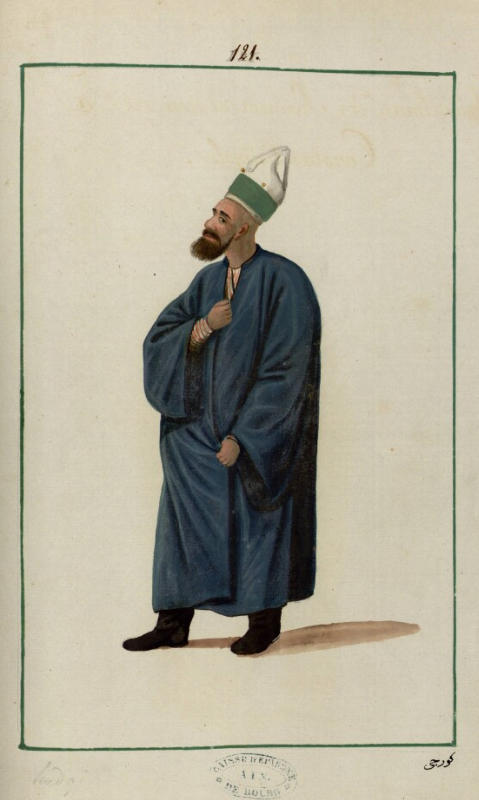Deveci
Illustration 121 from:
Costumes Orientaux
Recueil de costumes et vêtements de l'Empire ottoman au 18e siècle
Collection of costumes and clothing of the Ottoman Empire in the 18th century
Owned by Joseph Gabriel Monnier

Kurdgi : musulman des provinces de l'Empire, non né à Constantinople
Muslim from the provinces of the Empire, not born in Constantinople
The “Ortas” Nos 1, 2, 3 and 4 of the infantry (Yaya) were called Devecıs or “camel drivers”. The chiefs of these “Ortas” were above the others, because in the fortresses, where they were stationed, they were also responsible for the management of administrative affairs. According to Hammer, they wore a heron [plume] with a brilliant egret [plume] and had the right to put on yellow leather boots and ride on saddles embroidered in silver.
Source: État militaire ottoman depuis la fondation de l'Empire jusqu'a nos jours (1882) by A. Djevad Bey
64. Deveci
One of the aghas of the Janissaries, the deveciler (camel drivers) were also called sarban. They wore green trimmed headgear.
Source: Osmanlı kıyafet albümleri (1770-1810) by Nurdan Küçükhasköylü
DEVEDJI, a Turkish word meaning cameleer, the name given to certain regiments of the corps of janissaries [see YENI ČERI], forming part of the djemāʿat, and performing escort duties with the supply columns. They were also called by the Persian term shuturbān. The Devedjis originally formed the first five ortas of the djemāʿat (four according to D'Ohsson), and were later augmented to include many others. They wore heron's feathers in their crests (see SORGUČ); when attending the dīwān they wore velvet trimmed with sable and lynx fur. Devedji officers enjoyed high precedence among the ortas. According to Marsigli, the captains of the first five ortas were always preferred to the command of garrison centres. Their chief, the Bashdevedji, ranked high in the ladder of promotion, after the Khāṣṣeki Agha and above the Yaya-bashi.
Source: Islam Encyclopaedia by Brill
Bibliography: Marsigli, L’Etat militaire de l'Empire ottoman, The Hague 1732, i, 72; D’Ohsson, Tableau géneral de l'empire othoman, vii, Paris 1824, 343; Hammer-Purgstall, Histoire, iv, 217, 436; idem, Staatsverfassung, ii, 209; Aḥmed Djewād, Taʾrīk̲h̲-i ʿAskerī-i ʿOt̲h̲mānī, Istanbul 1299 A.H., 12 etc.; I. H. Uzunçarşılı, Osmanlı Devleti teşkilâtindan Kapıkulu Ocakları, i, Ankara 1943, index; Gibb-Bowen i/I, 321-2.
(B. Lewis)
Compare a

Deveci, Vol. I Folio 82. in Costumes Turcs, the Diez album.
Previous: Mısır Beyi
Next: Bursali Asker
Back to Costumes Orientaux Recueil de costumes et vêtements de l'Empire ottoman au 18e siècle. Owned by Joseph Gabriel Monnier.


